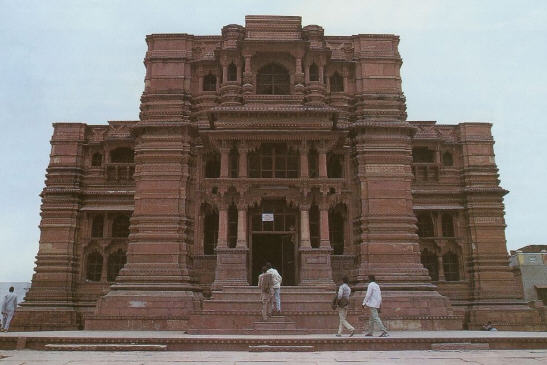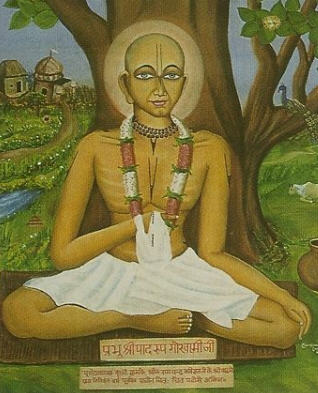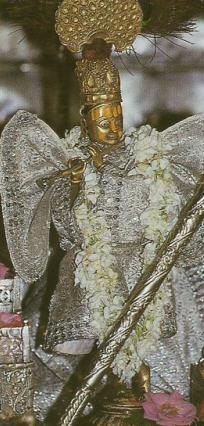
Though now worshiped with great devotion in Jaipur, the Govindaji Deity
appeared in Vrndavana, and His devotees there keep Him within their hearts.
THE GOVINDAJI DEITY of Jaipur was originally installed in a beautiful temple in Vrndavana by Srila Rupa Gosvami, one of the main contemporary followers of Lord Sri Caitanya Mahaprabhu.
Rupa Gosvami and his elder brother, Sanatana Gosvami, were born in a brahmana family, and their given names were Amara Deva and Santosh Deva. They grew up in Ramakeli, then the capital of Gauda Desa (now West Bengal). After the early death of their father, their grandfather Mukunda Deva, a high-ranking government officer, raised them and taught them Sanskrit and Arabic.
Rupa and Sanatana then served as prime minister and treasury minister in the government of the Mogul king Hussain Shah. Impressed with their work, the king gave the title Sakar Mallik to Sanatana, and Dabhir Khas to Rupa. Because the brothers adopted the customary beards and dress of Muslims, they were accused of becoming Muslims. Despite these charges, however, Rupa and Sanatana regularly discussed the Vedic scriptures, worshiped the Deity, and remembered the pastimes of Radha and Krsna. Actually, they were patiently waiting for the mercy of Krsna while reluctantly serving the Mogul government.
The Mercy of Lord Caitanya

The brothers heard of the glories of Sri Caitanya Mahaprabhu and wrote to Him, begging for mercy. Mahaprabhu purified the brothers by coming to Ramakeli and changing their names to Rupa Gosvami and Sanatana Gosvami.
After some time Rupa Gosvami left his job, friends, and family to take complete shelter of Mahaprabhu. Following Mahaprabhu's path through the Jharikhanda Forest, Rupa Gosvami hurried toward Vrndavana.
When Rupa arrived in Prayag (Allahabad), he heard that Sri Caitanya, having returned from Vrndavana, was staying at Dasasvamedha Ghata, beside the Triveni, the confluence of three holy rivers. Rupa ran there and offered obeisances to the Lord, who embraced him.
For the next ten days Mahaprabhu spoke to Rupa about prema-dharma, pure devotional service. Even today that place by the Dasasvamedha Ghata is called Rupa Siksasthali, "the place where Lord Caitanya taught and inspired Rupa Gosvami in the science of bhakti." Sri Caitanya told Rupa to first visit Vrndavana and then meet Him later in Jagannatha Puri.
In Mathura, Rupa Gosvami met Subuddhi Raya, a great devotee of Lord Caitanya and a former king of Gauda Desa. Rupa wandered in Vraja Mandala (Vrndavana) visiting the places of Radha-Krsna's pastimes.
After staying briefly in Vrndavana, Rupa went to Puri, where he shared a cottage by the ocean with Thakura Haridasa. There Rupa Gosvami began writing two dramas, Vidagdha Madhava and Lalita Madhava.Daily Sri Caitanya would visit Rupa and Haridasa and talk about Krsna. After ten months Lord Caitanya asked Rupa to move to Vrndavana.
Govindaji Discovered
After a long separation, Sanatana met Rupa in Vrndavana, and together they wrote books, taught Krsna consciousness, and found the lost places of Radha-Krsna's pastimes.
From old scriptures they learned that a beautiful Deity of Govindaji (Krsna) had been installed at a place known as Yogapitha in Vrndavana five thousand years ago by Vrajanabha, king of Mathura, the great-grandson of Lord Krsna. Eager to find the lost Deity, Rupa and Sanatana searched Vrndavana, constantly crying out, "O Govinda! O Govinda!"
One day a brahmana boy told Rupa that the Yogapitha he was looking for was now called Goma Tila. Every day a cow poured milk into a hole on top of this tila (hill). Realizing that Goma Tila was a special place, Rupa asked the Vrajavasis (the residents of Vraja, or Vrndavana) to dig up the ground. When they found a gorgeous black Deity of Krsna, everyone spontaneously chanted, "Govindadeva ki jaya! Govindadeva ki jaya!" ("All glories to Lord Govinda!")
On hearing the news of Govindaji's appearance, Lord Caitanya sent Kasisvara Pandita to Vrndavana from Puri, giving him a Deity of Lord Krsna to take with him. Kasisvara Pandita installed the Deity, named Gaura-Govinda, or "Golden Govinda," next to Govindaji. Gaura-Govinda is still worshiped in Jaipur in the Govindaji temple compound.
The Govindaji Temple in Vrndavana
The Govindaji temple in Vrndavana was built by king Man Singh in 1590, at the time of Jiva Gosvami (the nephew of Rupa Gosvami and Sanatana Gosvami). It is the second oldest temple in Vrndavana. The red sandstone used in the construction, although at the time reserved for government buildings, was donated by the Mogul emperor Akbar to his friend Man Singh. Emperor Akbar also gave seventy acres of land for Govindaji's upkeep.
The deep red of the stone, the ornately carved designs, and the temple's massive size distinguish the Govindaji temple from all others in Vrndavana. The highest dome, in the center of the temple, has a huge lotus flower intricately carved from a single slab of red stone.
A stone panel outside the temple states that Man Singh built the temple with stone given by Emperor Akbar. It also lists the completion date and the names of the architect and the chief mason.
Another stone panel, embedded in the wall beside the Deity room, bears Sanskrit verses. Although not completely readable, these verses resemble Jiva Gosvami's Govindastaka, eight prayers glorifying Lord Govinda.
Govindaji Goes to Jaipur

In 1669 Moguls destroyed many Vrndavana temples, including much of the Govindaji temple. Radha- Govindaji escaped by secretly moving to Radha-kunda, then to Kamya-vana, and finally to Govindapura, near Jaipur.
In 1772 the king of Jaipur placed Radha-Govinda in the garden temple behind the City Palace. Every day thousands of devotees from Jaipur and other places come to see Radha-Govinda and the Gaura-Govinda Deity of Kasisvara Pandita. The pujaris follow strict rules and regulations in worshiping Radha-Govindaji with sincerity and love.
In 1819-1825 Nanda Kumar Basu opened a new temple for worshiping the prati-bhu murtis (expansions of the original Deities) of Radha-Govinda in Vrndavana. This temple stands behind the original Govindaji temple and attracts hundreds of devotees daily.
In 1873, two hundred years after the Moguls had ransacked the beautiful Govindaji temple in Vrndavana, Mathura district magistrate F. S. Growse renovated it. Now the temple is a historical monument protected by the Indian government.
In place of Radha-Govindaji, the Gosvamis of Govindaji have installed Deities of Gaura-Nitai, Giridhari-sila, and Lord Jagannatha, Lord Balarama, and Subhadra Devi. A deity of Yogamaya (one of Krsna's energies), said to have been discovered by Srila Rupa Gosvami, is worshiped in an underground temple next door.
Still the devotees of Vrndavana want Sri Govindaji to return. Nowadays the Moguls no longer present a problem. I know that Sri Govindaji is treated just like a king in Jaipur, but still the devotees of Vrndavana have the Vrndavana mood of love for Govindadevaji. We request the present king to take this request sincerely.
Padma Nabha Goswami, son of Sri Vishwambhar Goswami, is one of the respected servitors of the Radha-Ramana Temple in Vrndavana.
